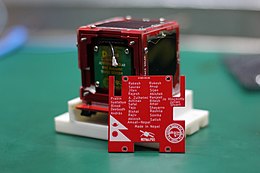Nepal PQ-1
 SanoSat-1 with the list of contributors | |
| Mission type | Space Engineering |
|---|---|
| Operator | AMSAT-Nepal |
| Spacecraft properties | |
| Manufacturer | |
Nepal-PQ1 also known as SanoSat-1 is a PocketQube being developed by . The first fully Nepal-made satellite is planned to be launched in January 2022.[1][2] It is also the first picosatellite of Nepal to be launched in 13th January, 2022 from Falcon 9.[3]
Background[]
The PocketQube is developed by ORION Space in collaboration with AMSAT-Nepal and AMSAT-EA, with the brokerage service offered by FOSSA Systems, a leading aerospace company focused on developing picosatellites for IoT communications. SanoSat-1 is a PocketQube of 1P size designed and developed with readily available commercial components (COTS) to measure space radiation while orbiting, and periodically transmit it to Earth. The satellite will act as a digital repeater in an amateur band. The store and forward concept can be used in remote disaster-prone locations. The same concept can also be used to collect data from ground-based sensors, store it onboard, and transmit it to Earth’s main station. The picosatellite has successfully passed all Environmental Testing Campaigns and is on its way to Cape Canaveral (Florida, USA), where it will be launched with SpaceX’s Falcon 9 vehicle. The satellite has a mass of 250 grams.[1]
Specifications[]
Section Source[2]
SANOSAT-1[]
- Country: Nepal
- Type: PocketQube
- Organisation: Orion Space
See also[]
References[]
- ^ a b Aryal, Timothy (1 February 2019). "One small step: First made-in-Nepal picosatellite to be launched into space in 2020". Kathmandu Post. Retrieved 2020-07-08.
- ^ a b "SANOSAT-1 [NEPAL-PQ1]". Orion Space. Retrieved 14 August 2020.
- ^ SanoSat-1 with Saurav Paudel || First Pico-Satellite || Made in Nepal || नेपाल मै बन्यो स्याटेलाइट. YouTube. Archived from the original on 2021-12-08.
External links[]
- CubeSats
- Picosatellites
- Satellites of Nepal
- 2020 in Nepal